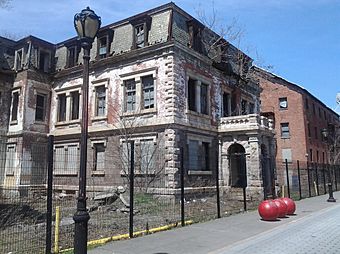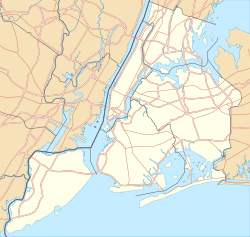St. George Coast Guard Station facts for kids
|
Office Building and U.S. Light-House Depot Complex
|
|

1869 Second Empire office building designed by Alfred B. Mullett as it appeared in 2014
|
|
| Location | 1 Bay St., Staten Island, New York |
|---|---|
| Area | 1.5 acres (0.61 ha) |
| Built | 1840 |
| Architect | Alfred B. Mullett |
| Architectural style | Greek Revival, Second Empire |
| NRHP reference No. | 83001785 |
Quick facts for kids Significant dates |
|
| Added to NRHP | September 15, 1983 |
The St. George Coast Guard Station, also known as the Staten Island Coast Guard Station, is a group of historic buildings. It is located right next to the Staten Island Ferry St. George Terminal. This site was once famous for creating and building equipment for lighthouses. The main building, called the Office Building and U.S. Light-House Depot Complex, was designed by Alfred B. Mullett and finished in 1865. These buildings are listed on the National Register of Historic Places and are official New York City Landmarks.
In the late 1990s, the New York City Economic Development Corporation (EDC) took over the area. They built a public space and a fishing pier (Pier 1). They also created a building meant to be a gift shop for the National Lighthouse Museum. The EDC also made sure the building next to the gift shop was safe to hold the Museum's artifacts. In 2015, the National Lighthouse Museum officially opened within this complex. A new development called Lighthouse Point is also being built right next to these historic buildings.
The site offers amazing views of the Verrazzano-Narrows Bridge, Brooklyn's Shore Parkway, Governors Island, and Manhattan. During the summer, local groups like Staten Island Community Board 1 and the Downtown Staten Island Council host concerts and events. These events bring in visitors from the ferry and local residents.
Contents
What's Inside the Complex?
The Office Building and U.S. Light-House Depot Complex is also known as the Old Administration Building for the Third District U.S. Coast Guard. It is a historic office building and a place where lighthouse parts were repaired. The complex has four main buildings. There is a three-story brick and sandstone office building built in the Second Empire style. There are also two brick warehouses and a small, one-story brick building. This smaller building was once used as a laboratory.
The office building was designed in 1869 by the Office of the Supervising Architect under Alfred B. Mullett. The warehouses were built around 1845 and in 1868. The older warehouse is built in the Greek Revival style.
Who Ran the Lighthouses?
The office building was built when the United States Lighthouse Board managed all U.S. lighthouses. This board started in 1851 to make lighthouse technology better and improve how they were managed. The board divided the country into 12 areas, called districts. Each district had a depot where supplies for its lighthouses were kept. This was especially important for flammable fuels, which needed special handling.
The depot in St. George, Staten Island, served the Third Lighthouse District. This district covered a large area from Maine to Delaware. It included many famous and old lighthouses on the East Coast. Some of these were Sandy Hook Light, Montauk Light, and Barnegat Light. Special underground rooms, called vaults, for fuel storage are still on the property. Other supplies were stored in the warehouses. The laboratory building was used to research new and better materials and methods for U.S. lighthouses.
The jobs of the Lighthouse Board were moved to other U.S. government groups starting in 1903. Finally, these jobs were given to the U.S. Coast Guard in 1939.
A Look Back in Time
The Site's Early Days
The land where the St. George Coast Guard Station now stands was once home to the New York Marine Hospital. This hospital, also known as the Quarantine, opened around 1799 or 1800. Long before the immigrant processing center on the Battery or Ellis Island, this hospital was where sick immigrants were kept separate. They were kept away from other immigrants and local people.
The Quarantine was New York City’s first way to stop infectious diseases like Smallpox, Cholera, Typhus, and Yellow fever from spreading. These diseases were often brought by immigrants. At one time, as many as 1,500 people could stay there. After several epidemics in the 1850s, local people were very upset. In 1858, during the Staten Island Quarantine War, a large group of locals destroyed the hospital complex.
Founding and Busy Years
The Staten Island Lighthouse Depot was built on the former hospital site in 1862. It was built by the United States Lighthouse Service (USLHS). This depot became the main place for making, storing, supplying, and fixing lighthouse equipment for the USLHS's 3rd District.
The Staten Island Depot grew steadily in size and ability in the late 1800s and early 1900s. It reached its busiest time during and after World War I. Two workshops were built to handle making and fixing lightship lenses. Most of these lenses weighed thousands of pounds and were several feet tall. Underground storage areas, called "The Vaults," were built to store fuels and other flammable items for lighthouses.
By the 1920s, a full machine shop and foundry were also working. Here, anchors, sinkers, chains, buoys, and parts for lighthouse structures were made.
As technology improved, many lighthouses became automated in the 1920s and 1930s. They were replaced with more reliable electronic beacons. This change greatly reduced the work at the Depot, as less upkeep and supply work for lighthouse keepers was needed. However, the use of Floating Aids-to-Navigation, or buoys, increased a lot. The Staten Island Depot's foundry became a key place for making and fixing many buoys used along the East Coast of the United States. Its docks became filled with ocean buoys, channel markers, ice buoys, and their chains, anchors, and sinkers.
Decline and New Life
When the USLHS joined the US Coast Guard in 1939, the Staten Island Depot continued its work. During World War II, it became more of a ship repair and outfitting place. Many USCG Cutters, buoy tenders, and harbor patrol boats came to the Depot for wartime repainting, arming, and repairs. After the war, the depot continued this work. By 1950, it was one of the US Coast Guard's main supply depots in the Northeast.
New technology again changed things for the Depot by the 1960s. All lighthouses had been automated with beacons that needed little maintenance. Only two lightships were still in use. The number of Buoy Tenders in USCG service also began to drop as each ship became more capable. Budget cuts and consolidation in the late 1960s meant much of the Staten Island Depot's work was moved. It went to the USCG Yard at Curtis Bay, Baltimore, Maryland. In 1966, the Coast Guard moved its remaining operations to Governors Island. The site then became extra property.
It seems that little was done to protect the site from damage and weather. It began to fall apart. The decline continued even after the Office Building became a New York City landmark in 1980. The entire site was listed on the National Register of Historic Places in 1983.
Redevelopment and the Museum
In the late 1990s, the New York City Economic Development Corporation bought the property. In 1998, the site was chosen to be the home of the National Lighthouse Museum. By this time, the buildings had been empty for over thirty years and needed serious repair. The museum started raising money again in 2010. By early 2014, they had raised over $400,000. This was enough to get a short-term lease on building 11, a machine shop from 1912 on the edge of the site. The museum continues to raise money. The museum first planned to open in building 11 in August 2014. However, its opening was delayed until the next year.
As of 2014, the other historic buildings, including the office building, were fenced off and in very bad shape. In April 2014, the Economic Development Corporation and a developer, Triangle Equities, announced their plan. They would build a complex, to be finished in 2019, called Lighthouse Point. This new complex would include the old historic buildings. It would also have a hotel, homes, and shops. Work started in 2016, and Lighthouse Point's opening was then moved to 2020. However, the developer faced financial problems in September 2019, which delayed the complex's opening.




